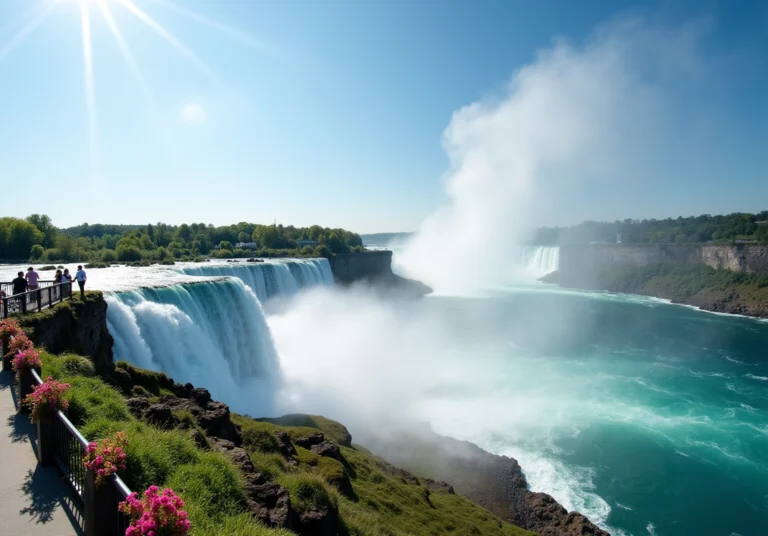Overview
This article takes you on a delightful journey comparing the attractions and experiences on both the American and Canadian sides of Niagara Falls. You’ll discover their unique features and offerings that make each side special.
On the American side, you can soak in the natural beauty and historical significance that define its charm. Meanwhile, the Canadian side offers a more commercialized experience, bursting with diverse entertainment options that cater to a wide range of tourist interests.
Isn’t it exciting to think about all the adventures waiting for you at this iconic destination?
Key Highlights:
- Niagara Falls consists of three waterfalls: the US Cascades, Bridal Veil, and Horseshoe, located along the Niagara River between Lake Erie and Lake Ontario.
- The Horseshoe Waterfall is the largest, with a height of 48 metres and a width of 792 metres, while the Bridal Veil is 55 metres tall and 17 metres wide.
- The geological composition includes dolostone and shale, shaped by erosion and glacial activity, with ongoing erosion estimated at one foot per year.
- The total flow rate is approximately 75,750 gallons per second for the Bridal Veil and Horseshoe cascades, with the Horseshoe alone at 681,750 gallons per second.
- Niagara Falls generates around 4.4 million kilowatts of hydroelectric power shared between the US and Canada.
- The American side features attractions like the Maid of the Mist boat tour and Cave of the Winds, while the Canadian side offers the Skylon Tower and Journey Behind the Falls.
- Travel between the US and Canadian sides is facilitated by the Rainbow Bridge, with a focus on accessibility for visitors with mobility challenges.
- Cultural experiences on the US side include the Falls National Heritage Area and the History Museum, while the Canadian side features the Parks Botanical Gardens and cultural festivals.
- Tourism significantly impacts the local economy, contributing about $2.4 billion annually, with millions visiting each year.
Introduction
Niagara Falls is truly a marvel of nature, showcasing three distinct waterfalls that attract millions of visitors each year! If you find yourself on the American side, you’ll enjoy a close-up encounter with these stunning cascades. Here, attractions immerse you in their raw beauty, making for a memorable experience. On the other hand, the Canadian side offers a more commercialized vibe, bursting with diverse entertainment options that cater to every taste.
As you weigh the allure of tranquility against the thrill of adventure, you might wonder: which side truly captures the essence of Niagara Falls? What unique experiences await you as you explore both perspectives? Let’s dive into the wonders that each side has to offer!
Overview of Niagara Falls: Geography and Composition
Niagara is home to three magnificent waterfalls: the US Cascades, Bridal Veil, and Horseshoe, all nestled along the Niagara River, which connects Lake Erie to Lake Ontario. The American waterfall stands tall at 51 meters (167 feet) high and 323 meters (1,060 feet) wide, showcasing a dramatic drop. Right next to it, the more subtle Bridal Veil cascade reaches 55 meters (181 feet) in height and spans 17 meters (56 feet) wide. Meanwhile, the Horseshoe Waterfall, located on the Canadian side, is the most extensive and powerful, soaring to 48 meters (158 feet) high and stretching 792 meters (2,600 feet) wide.
The geological foundation of these falls is primarily made up of dolostone and shale, shaped over millennia by the forces of erosion and glacial activity. This unique geological composition not only contributes to the breathtaking views but also plays a crucial role in forming the American view of Niagara Falls and the types of attractions and experiences available on both sides of the falls. Did you know that ongoing erosion is estimated at about one foot per year, though it might slow down to one foot every ten years? This fascinating process has been a focal point of geological studies, revealing insights into the natural forces that continue to sculpt this iconic landscape.
The cascades boast a total flow rate of about 75,750 gallons per second for the Bridal Veil and Horseshoe cascades, with the Horseshoe itself pouring out an astonishing 681,750 gallons per second! This immense volume of water, combined with the falls’ geological history, highlights their significance in the American view of Niagara Falls as both a natural wonder and a vital source of hydroelectric power, generating around 4.4 million kilowatts of electricity shared between the United States and Canada.
As you explore the region, you’ll not only appreciate the stunning vistas but also the rich geological narrative that has unfolded over the last 12,000 years. This remarkable destination is perfect for those looking to connect with nature’s artistry. The name ‘Niagara’ originates from First Nations, meaning ‘thunder of waters,’ and is steeped in local legends, including that of the Maid of the Mist, adding to the cultural significance of this breathtaking site.
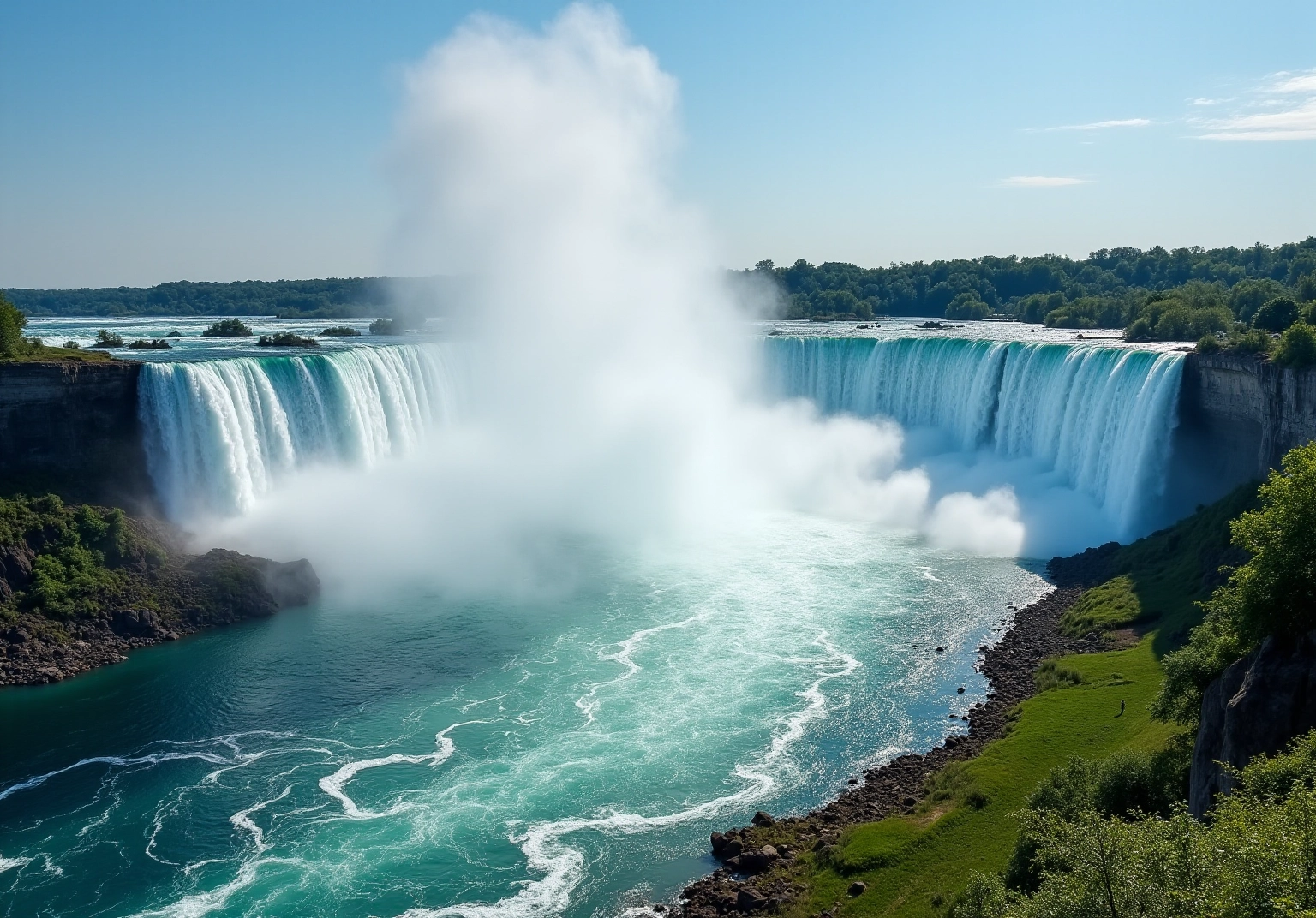
Comparative Attractions: American Side vs. Canadian Side
The American side of the waterfall offers a truly personal experience with the cascades! You can get up close through attractions like the Maid of the Mist boat tour, the oldest and most recognized tourist site here since 1846. It’s no wonder this tour attracts over 1.5 million visitors in 2024!
And don’t miss the Cave of the Winds tour! It’s an exhilarating chance to feel the raw energy of the Bridal Veil waterfall, with attendance expected to surpass 500,000 in 2025. Travel expert Karen LeBlanc captures it perfectly: “The Cave of the Winds offers an unparalleled opportunity to feel the raw energy of the falls up close, making it a must-see for anyone visiting the area.”
If you’re looking for a bit of nature, the State Park spans more than 400 acres and is anticipating over 9 million visitors in 2025. Picture yourself wandering through picturesque trails, enjoying picnic spots, and taking in breathtaking views from the Observation Tower. Plus, the Niagara River Recreational Trail stretches 56 km, inviting outdoor enthusiasts like you to explore the area’s natural beauty.
Now, let’s talk about the Canadian side! It boasts a wider array of attractions, including the iconic Skylon Tower, where you can soak in breathtaking views from the observation deck. The Journey Behind the Falls is another highlight, allowing you to explore tunnels that lead to observation points right behind the Horseshoe Falls.
And if you’re in the mood for some vibrant entertainment, Clifton Hill is the place to be, filled with arcades, restaurants, and nightlife! While the American view of Niagara Falls emphasizes natural beauty and serenity, the Canadian viewpoint tends to lean towards a more commercialized and varied experience, catering to a broader range of interests. So, whether you’re seeking tranquility or excitement, both sides have something special to offer!
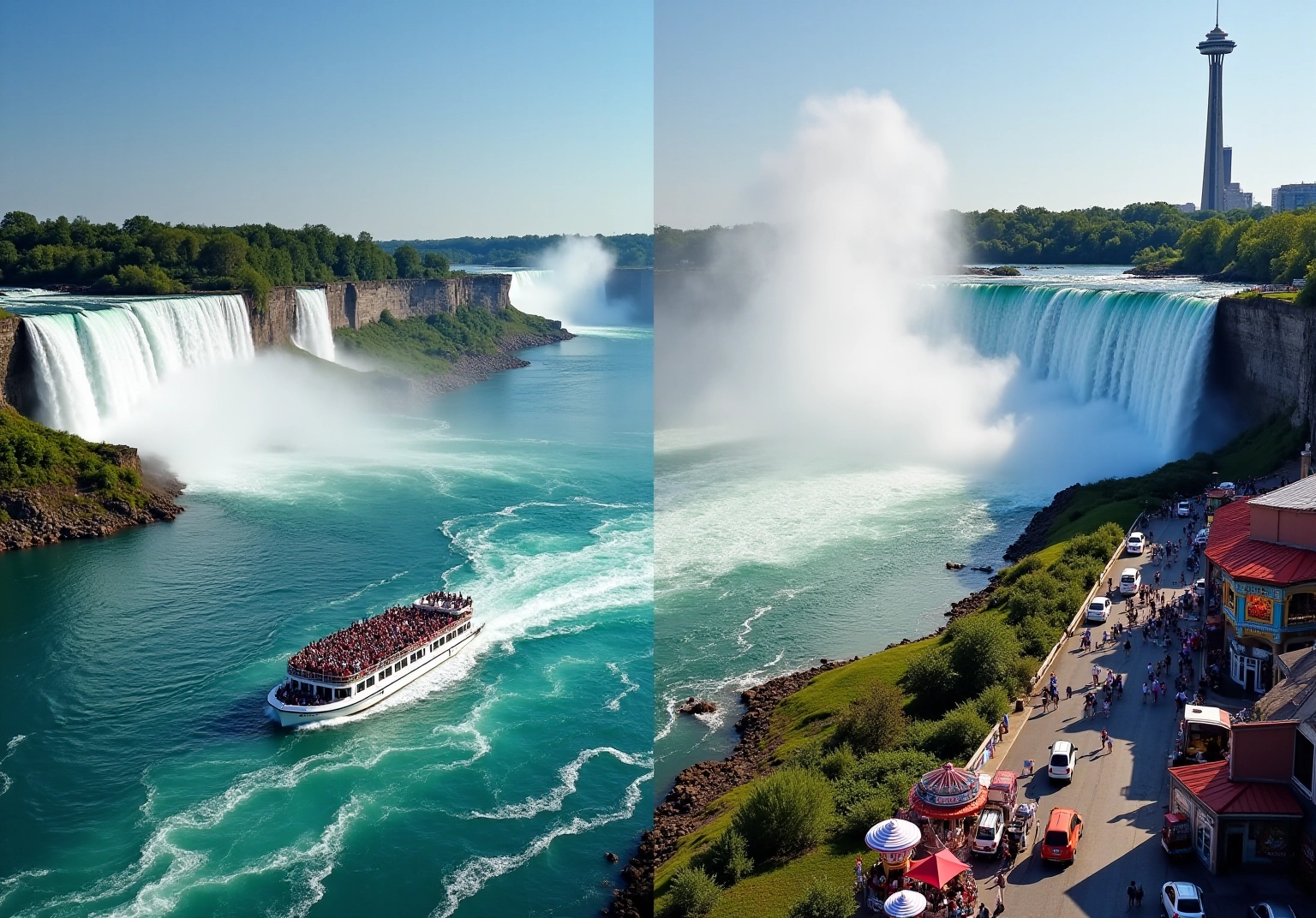
Travel Logistics: Crossing Borders and Accessibility
Journeying between the U.S. and Canadian areas of the waterfall is a breeze, thanks to various border crossings. The Rainbow Bridge is the go-to choice for walkers! Just remember to bring your valid documentation, like a passport or enhanced driver’s license, to cross the border. While the crossing process is generally smooth, wait times can vary, especially during those busy tourist seasons.
On the American side, reaching the waterfall state park is easy by car or public transport. Meanwhile, the Canadian side boasts a fantastic transit system, including the WEGO bus service, which makes accessing major attractions super convenient.
Accessibility is a big focus for both countries, with facilities and services tailored for visitors with mobility challenges. Recent data shows that the Rainbow Bridge pedestrian crossing is a vital link for tourists, enhancing their experience by providing easy access to stunning views and attractions. However, it’s important to acknowledge the recent vehicle explosion at the Rainbow Bridge, which sadly resulted in the tragic deaths of two individuals. Authorities have confirmed that there are no signs of terrorism related to this incident. As New York Governor Kathy Hochul stated, “based on what we know at this moment, there is no sign of terrorist activity in this crash.” Erie County Sheriff John Garcia reassured everyone, saying, “We can go on with our lives.”
Understanding these travel logistics, especially considering recent events, is essential for making the most of your visit to the American view of Niagara Falls. This way, you can effortlessly explore the unique offerings of both sides while soaking in the breathtaking natural beauty and cultural significance of the region.
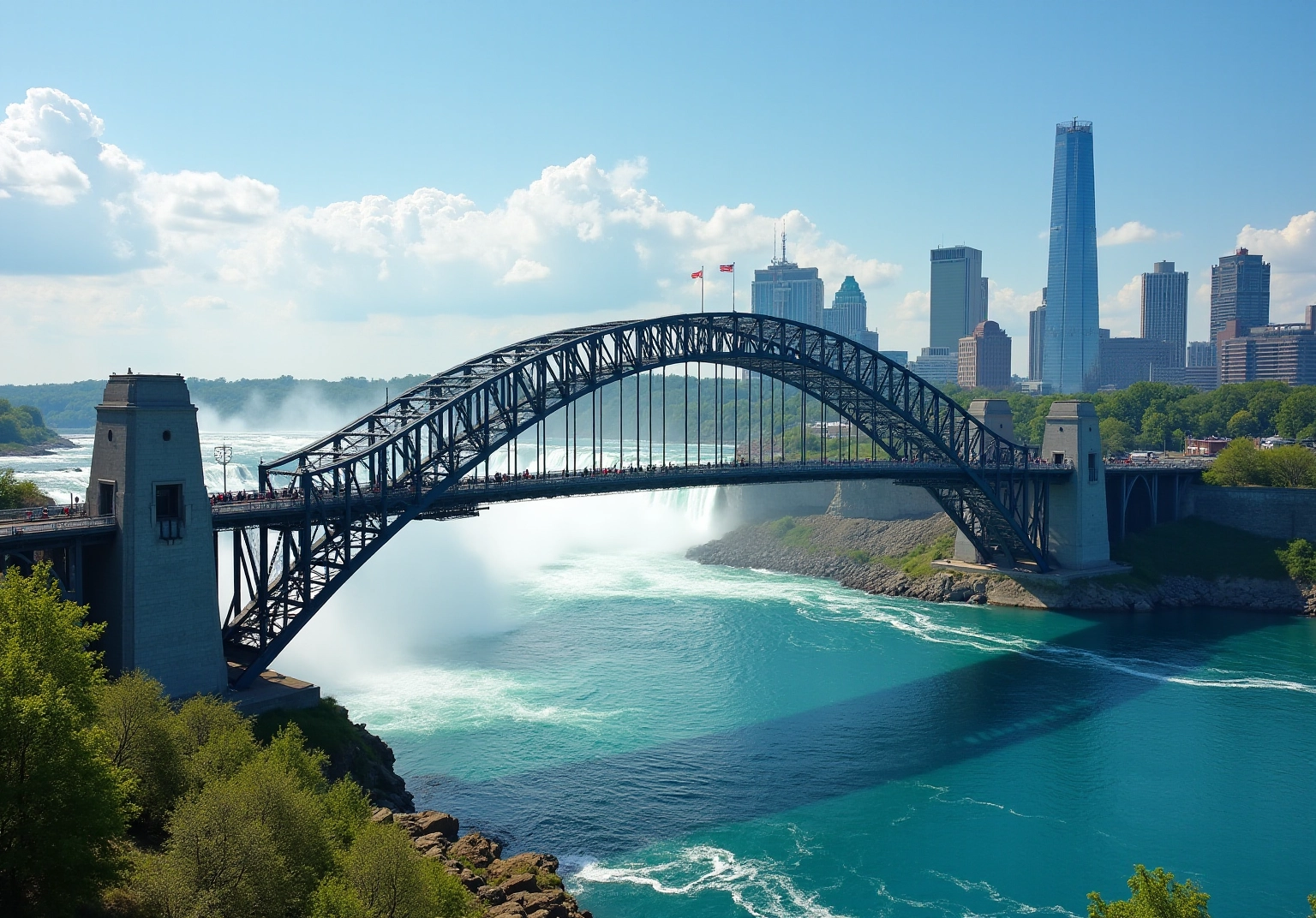
Cultural Experiences: Art and History at Niagara Falls
The U.S. side of the waterfalls is a treasure trove of cultural encounters, showcasing the area’s rich heritage and creativity. At the heart of this is the Falls National Heritage Area, which highlights the falls’ historical significance and its role in the Underground Railroad, shaping the American view of Niagara Falls and its influence on early tourism in the United States. Did you know that around 8 to 9 million visitors come here each year? That’s a huge boost for the local economy, contributing about $2.4 billion through tourism!
You can dive into the past at the History Museum, where fascinating displays and historical markers throughout the park narrate the area’s vibrant legacy. On the flip side, the Canadian side boasts attractions like the Parks Botanical Gardens and the Floral Clock, showcasing the beauty of local horticultural artistry. Plus, cultural festivals, such as the Niagara Falls Music Festival, celebrate the region’s artistic spirit!
By immersing yourself in these cultural experiences, you can uncover the stories behind the falls, creating a deeper connection to this iconic destination. If you’re planning a visit, the summer months are fantastic when all attractions are in full swing. For a more peaceful experience, consider late August to September when the crowds thin out a bit!
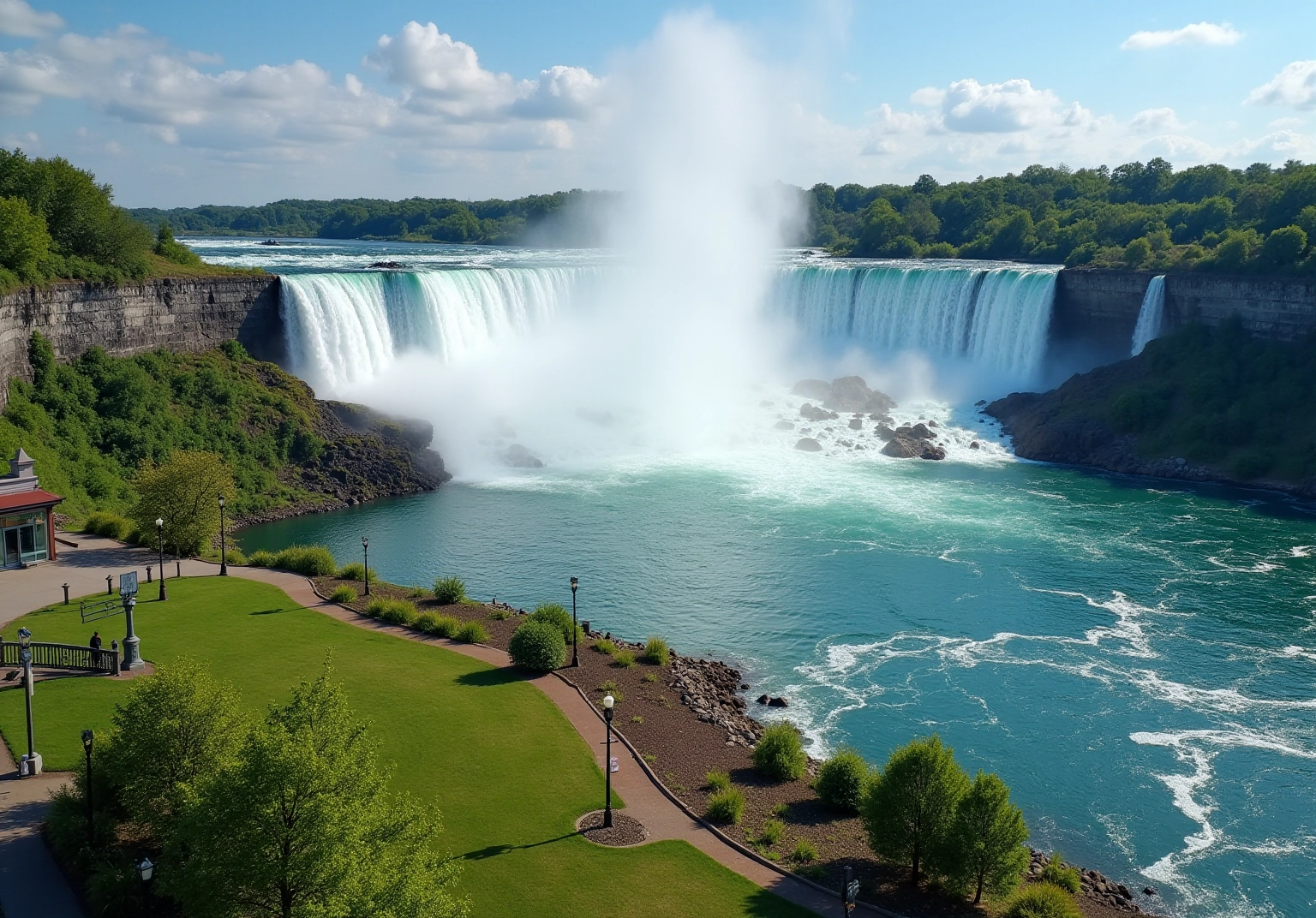
Conclusion
The American view of Niagara Falls offers a delightful mix of natural beauty and cultural significance, showcasing the falls as a vital part of both the landscape and the region’s history. Picture the breathtaking geological features, from the impressive heights to the powerful flow rates of the waterfalls, while also enjoying the intimate experiences available on the American side.
Key attractions like the Maid of the Mist and Cave of the Winds invite you to engage with the falls up close, fostering a deep appreciation for their raw power. In contrast, the Canadian side provides a more commercialized experience, complete with diverse entertainment options and panoramic views. The ease of crossing the border means you can enjoy the best of both worlds, while the rich cultural heritage found on the American side enhances your overall visit.
Ultimately, whether you’re seeking tranquility in nature or vibrant entertainment, Niagara Falls stands as a testament to the beauty of collaboration between the United States and Canada. Embracing both perspectives not only enriches your visit but also deepens your understanding of this iconic landmark’s role in history, culture, and the natural world. Exploring the American view of Niagara Falls is an invitation to connect with a destination that continues to inspire awe and admiration, making it a must-visit for travelers like you who seek adventure and enlightenment!
Frequently Asked Questions
What are the main waterfalls located at Niagara Falls?
Niagara Falls is home to three main waterfalls: the US Cascades, Bridal Veil, and Horseshoe Waterfall.
How high and wide are the waterfalls at Niagara Falls?
The American waterfall (US Cascades) is 51 meters (167 feet) high and 323 meters (1,060 feet) wide. The Bridal Veil cascade is 55 meters (181 feet) high and 17 meters (56 feet) wide. The Horseshoe Waterfall, located on the Canadian side, is 48 meters (158 feet) high and 792 meters (2,600 feet) wide.
What geological materials make up Niagara Falls?
The geological foundation of Niagara Falls is primarily composed of dolostone and shale, shaped by erosion and glacial activity over millennia.
How does erosion affect Niagara Falls?
Ongoing erosion at Niagara Falls is estimated at about one foot per year, although it may slow to one foot every ten years. This process has been a focus of geological studies, revealing insights into the natural forces that shape the landscape.
What is the flow rate of water at Niagara Falls?
The total flow rate for the Bridal Veil and Horseshoe cascades is about 75,750 gallons per second, while the Horseshoe Waterfall itself pours out an astonishing 681,750 gallons per second.
How does Niagara Falls contribute to hydroelectric power?
Niagara Falls generates around 4.4 million kilowatts of electricity, which is shared between the United States and Canada, highlighting its significance as a source of hydroelectric power.
What is the historical significance of the name ‘Niagara’?
The name ‘Niagara’ originates from First Nations, meaning ‘thunder of waters,’ and is associated with local legends, including that of the Maid of the Mist, adding to the cultural significance of the site.
How long has the geological narrative of Niagara Falls been unfolding?
The geological narrative of Niagara Falls has been unfolding over the last 12,000 years, showcasing the region’s rich natural history.









